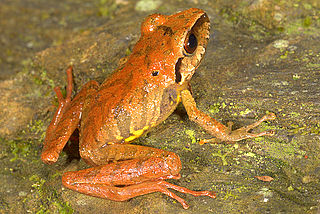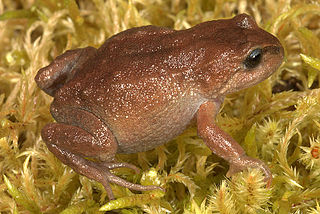
The Brachycephalidae are a family of frogs confined to eastern and southern Brazil and northern Argentina. The family is composed of two externally quite different genera: the tiny, often colourful and plump saddleback toads (Brachycephalus) from Brazil, and the larger, slimmer and more drab genus Ischnocnema from both Brazil and Argentina. The family is mainly defined by molecular characteristics, and are linked by few anatomical features. It was erected from two genera of the previously large family Eleutherodactylidae, which is now split into four families.

The Eleutherodactylidae are a family of direct-developing frogs native to northern South America, the Caribbean, and southernmost North America. They are sometimes known under the common name rain frogs. Formerly the subfamily Eleutherodactylinae of the family Leptodactylidae, it was raised to the family status following a major revision of New World direct-developing frogs in 2008. As currently defined, the family has more than 200 species.

Barycholos, common name Chimbo frogs, is a genus of small frogs in the family Strabomantidae found in south-eastern Brazil and tropical lowland Ecuador. The name Barycholos, from the Greek βαρύχολος ("savage"), is in honor of herpetologist Jay M. Savage.

Euparkerella, sometimes known as Guanabara frogs, is a genus of frogs in the family Strabomantidae. They are endemic to the Atlantic coastal forests in the south-eastern Brazilian states of Espírito Santo and Rio de Janeiro. The name Euparkerella honours H. W. Parker, a herpetologist who named the type species, with the Greek prefix eu meaning true and suffix ella, a diminutive form.
Holoaden, the highland frogs, is a small genus of frogs in the family Strabomantidae. The species are endemic to south-eastern Brazil.

Phrynopus is a genus of frogs of the family Strabomantidae. Their common name is Andes frogs. They are endemic to Peru and inhabit the upper humid montane forest and supra-treeline grassland in the Cordillera Oriental, with one record from the Peruvian Cordillera Occidental.

Cryptobatrachus is a genus of frogs in the family Hemiphractidae. They are found in Colombia and Venezuela. They are also known as backpack frogs, as the females have the habit of carrying their egg clutch on their backs until the young hatch; this behavior also occurs in the related hemiphractid genera Hemiphractus and Stefania.
Craugastor phasma is a species of frog in the family Craugastoridae. It is endemic to southeastern Costa Rica and only known from its type locality in the Las Tablas protected area in the Puntarenas Province, near the Panamanian border. Only a single individual—the holotype collected in 1992—has ever been observed. It is unusual in its ghost-like, gray-white coloration, and it was initially thought that the specimen was an albino form of some other species. However, the specimen is also morphologically distinct, although some uncertainty regarding the validity of this species remains.
Diasporus hylaeformis, also known as the Pico Blanco robber frog or the montane dink frog, is a species of frog in the family Eleutherodactylidae. It is found in humid mountain areas in Costa Rica and Panama. Its natural habitats are dense montane forest and tropical rainforest. It is an abundant, nocturnal species found in low vegetation.

Bryophryne is a genus of frogs in the family Strabomantidae. These frogs are endemic to south-eastern Peru in the Cusco Region, with an undescribed species from the Puno Region. Their range is separated from that of Phrynopus by the Apurímac River valley.

Craugastoridae, commonly known as fleshbelly frogs, is a family of New World direct-developing frogs. As delineated here, following the Amphibian Species of the World, it contains 129 species. They are found from the southern United States southwards to Central and South America.

Strabomantis is a genus of frogs in the family Strabomantidae. At times these frogs have been included in the large genus Eleutherodactylus. They are distributed from Costa Rica southwards to northern South America.

Diasporus is a genus of frogs in the family Eleutherodactylidae. The genus was first described in 2008. They are found in Central and northern South America. They are sometimes referred to as dink frogs, in reference to the "tink" sound that males make during the mating season.

Lynchius is a genus of frogs in the family Strabomantidae. The name honours herpetologist John D. Lynch. The distribution of Lynchius is restricted to the Cordillera Oriental in southern Ecuador and Cordillera de Huancabamba in northern Peru.

Psychrophrynella is a genus of frogs in the family Strabomantidae The genus is distributed on the Andes of southern Peru and Bolivia. One of the four species assessed by the International Union for Conservation of Nature (IUCN) is assessed as "Critically Endangered".

Niceforonia is a genus of frogs in the family Strabomantidae found in northern South America. The name refers to Nicéforo María, Colombian herpetologist.

Noblella is a genus of frogs in the family Strabomantidae. They are found on the eastern slopes of the Andes and in the Amazon Basin in Colombia, Ecuador, Peru, Bolivia, and western Brazil. The name refers to Gladwyn K. Noble, who described the first species.

Ceuthomantis is a small genus of craugastorid frogs, also treated as comprising their own monogeneric family Ceuthomantidae. They are found in the southern and eastern parts of the Guiana Highlands in Venezuela, Guyana, and Brazil. The generic name is derived from the Greek noun mantis, which means treefrog, and adjective keuthos, which means hidden, in allusion to the hidden existence of this genus in the tepuis of the Guiana Shield.
Ceuthomantis duellmani is a species of frog in the family Ceuthomantidae. It is endemic to the Sarisariñama tepui, Bolívar state, in the southeastern Venezuela. It is named in honour of William Edward Duellman, herpetologist from the University of Kansas.
Brachycephaloidea (Terrarana) is a monophyletic group of frogs that includes the families: Brachycephalidae, Caligophrynidae, Craugastoridae, Eleutherodactylidae, Ceuthomantidae, Neblinaphrynidae and Strabomantidae. The superfamily contains 882 species that inhabit the New World tropics, subtropics, and Andean regions. The group has undergone extensive changes in its taxonomy thanks to multiple molecular phylogenetic analyses in recent years. Until 2008, these species were placed in a single, large family (Brachycephalidae) new analysis from 344 species were used to estimate their relationship. A new taxon name, Terrarana, including the same families is sometimes used.














